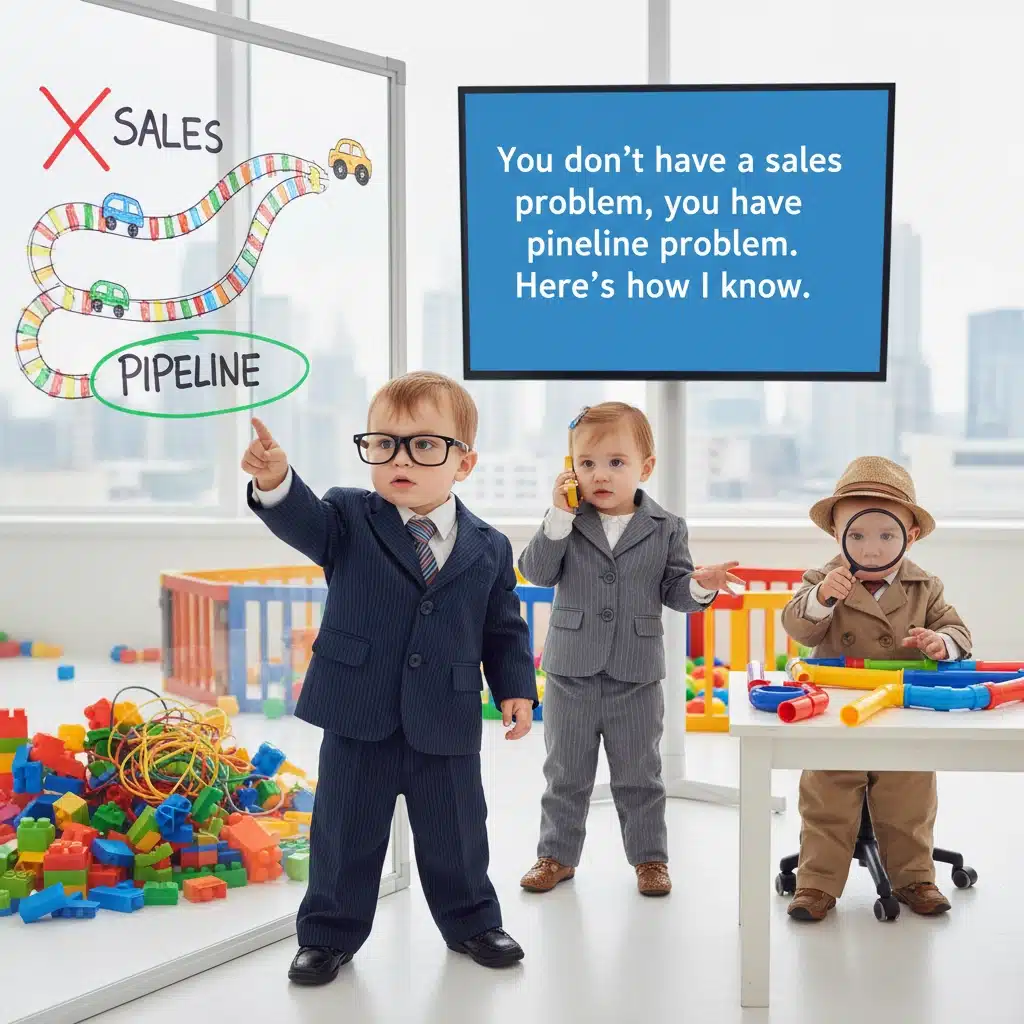Last month, I had a conversation with a VP of Sales who was convinced his team just wasn’t closing enough deals. “They need better sales training,” he said. “Maybe more cold calling. Something to get them motivated.”
Here’s the thing though, his sales team was actually pretty good. The real issue? They were spending 70% of their time chasing prospects who weren’t ready to buy, had no budget, or weren’t even the right fit for their solution.
That’s not a sales problem. That’s a pipeline problem.
What Actually Is a Pipeline Problem?
A pipeline problem happens when your marketing and lead generation systems aren’t feeding your sales team the right prospects at the right time. It’s like having a talented chef in a kitchen with no fresh ingredients. They can cook, but they can’t create great meals with what they’ve been given.
Here are the telltale signs you’re dealing with a pipeline issue:
Your CRM is full of “maybe someday” prospects. You know the ones, contacts who expressed interest six months ago but haven’t responded to follow-ups. They’re clogging your pipeline and making your forecasting meaningless.
Your team spends more time prospecting than nurturing. When salespeople are constantly hunting for new leads instead of developing relationships with qualified prospects, your pipeline isn’t working.
Lead quality is inconsistent. Some weeks you get great prospects who are ready to talk. Other weeks, you’re lucky if anyone returns a call. This feast-or-famine cycle screams pipeline problem.
Your sales cycle is unpredictable. Without a steady flow of properly nurtured prospects, deals either happen fast (when you get lucky) or drag on forever (when you’re forcing unready prospects through your process).

Why “Just Sell Harder” Doesn’t Fix Anything
When pipeline problems show up as missed quotas, the instinct is to push the sales team harder. More calls. More meetings. More hustle. But this approach backfires for a few reasons:
It burns out your best people. Good salespeople know when they’re fighting an uphill battle. When they spend weeks chasing prospects who aren’t qualified or ready, they get frustrated and start looking for jobs elsewhere.
It wastes everyone’s time. Your prospects get annoyed by pushy follow-ups. Your salespeople get discouraged by constant rejection. Your close rates plummet because you’re trying to force conversations that shouldn’t be happening yet.
It doesn’t scale. Even if individual reps can muscle through and hit their numbers occasionally, this approach can’t grow with your business. You’ll always be dependent on heroic individual efforts rather than reliable systems.
The Truth About Modern B2B Buying
Here’s what’s really happening in your prospect’s world: they’re doing most of their research before they ever talk to a salesperson. According to recent studies, B2B buyers complete 84% of their purchasing decision before engaging with sales.
This means by the time someone reaches out to your team, they’ve probably:
- Researched multiple solutions
- Discussed options with their team
- Started forming opinions about which direction to go
- Maybe even allocated budget
If your pipeline isn’t capturing and nurturing prospects during this early research phase, you’re missing the most important part of their buying journey.

How DirectReach Solves the Pipeline Problem
At MEMO Marketing Group, we built DirectReach specifically to fix these pipeline issues. Here’s how it works:
Step 1: Identify Best-Fit Prospects
Instead of casting a wide net and hoping for the best, DirectReach uses firmographic data to build precise lists of companies and decision-makers who actually need your solution. No more wasting time on prospects who can’t afford you or don’t have the problem you solve.
Step 2: Attract with Helpful Content
While your prospects are researching solutions, DirectReach shows them targeted ads and resources that educate rather than pitch. We’re building trust and demonstrating expertise while they’re in learning mode, not selling mode.
Step 3: Track Engagement and Buying Signals
The system monitors who’s interacting with your content, how they engage, and when their behavior suggests they’re moving from research to evaluation. This gives you real intelligence about prospect readiness.
Step 4: Surface Warm, Qualified Prospects
Instead of your sales team making cold calls, DirectReach identifies prospects who have already engaged with your content and are showing signs of buying interest. Your team gets to have conversations with people who actually want to talk.
Diagnose Your Own Pipeline
Want to know if you have a pipeline problem? Ask yourself these questions:
- Do you know where your next 10 qualified prospects are coming from?
- Can you predict your lead flow for next month with confidence?
- Are your salespeople spending more than 40% of their time prospecting?
- Do prospects frequently say “we’re not ready yet” or “we’re just looking”?
- Has your sales cycle gotten longer over the past year?
If you answered “no” to the first two questions or “yes” to any of the others, you’ve got pipeline issues that no amount of sales coaching will fix.

What Happens When You Fix Your Pipeline
When your pipeline starts working properly, everything changes:
Your sales team becomes more effective. Instead of spending time chasing cold prospects, they’re having meaningful conversations with people who are ready to explore solutions.
Your close rates improve. When prospects have already consumed your educational content and trust your expertise, they’re more likely to move forward with you.
Your sales cycle becomes predictable. With a steady flow of properly nurtured prospects, you can forecast revenue more accurately and plan growth with confidence.
Your team stays motivated. Salespeople love having qualified prospects to call. It’s energizing to work with people who actually want your help.
Most importantly, you get a consistent stream of opportunities that aren’t dependent on individual heroics or market timing. Your business becomes scalable because your growth is driven by systems, not luck.
Take Action on Your Pipeline
If you recognize the signs of a pipeline problem in your business, don’t waste time trying to solve it with more sales training or activity metrics. The issue is systematic, and it requires a systematic solution.
Start by auditing your current lead generation process. Where are prospects coming from? How are they being nurtured before sales gets involved? What signals indicate they’re ready for a conversation?
If you don’t have good answers to these questions, or if you want to see how DirectReach could transform your pipeline, let’s talk. We’ll analyze your current situation and show you exactly how to build a pipeline that consistently delivers qualified prospects who are ready to engage.
The result? Your sales team gets a steady flow of warm, qualified leads who are primed and ready for productive conversations.

